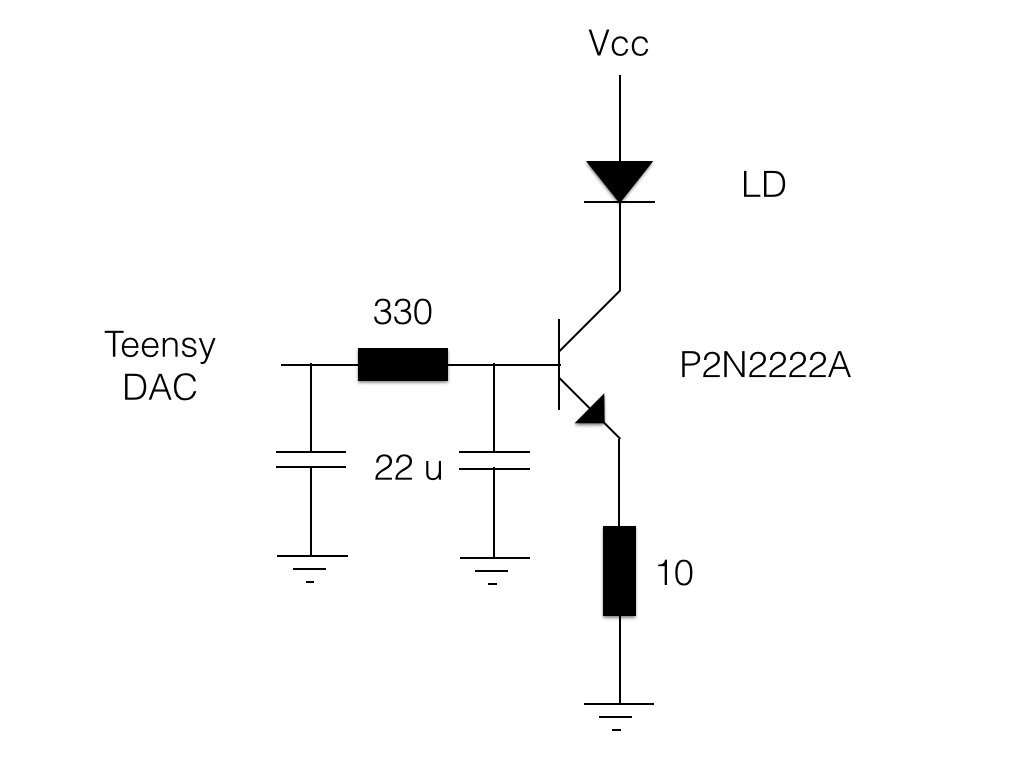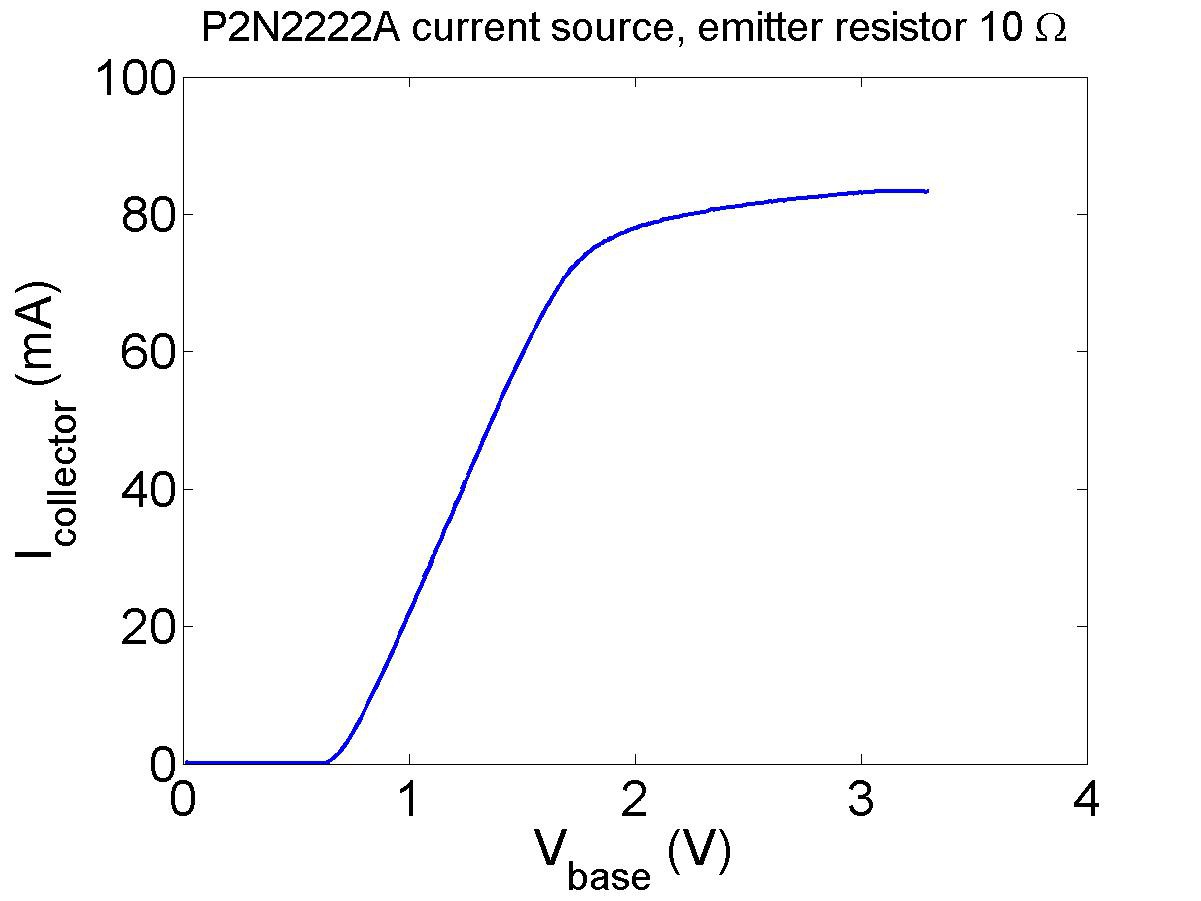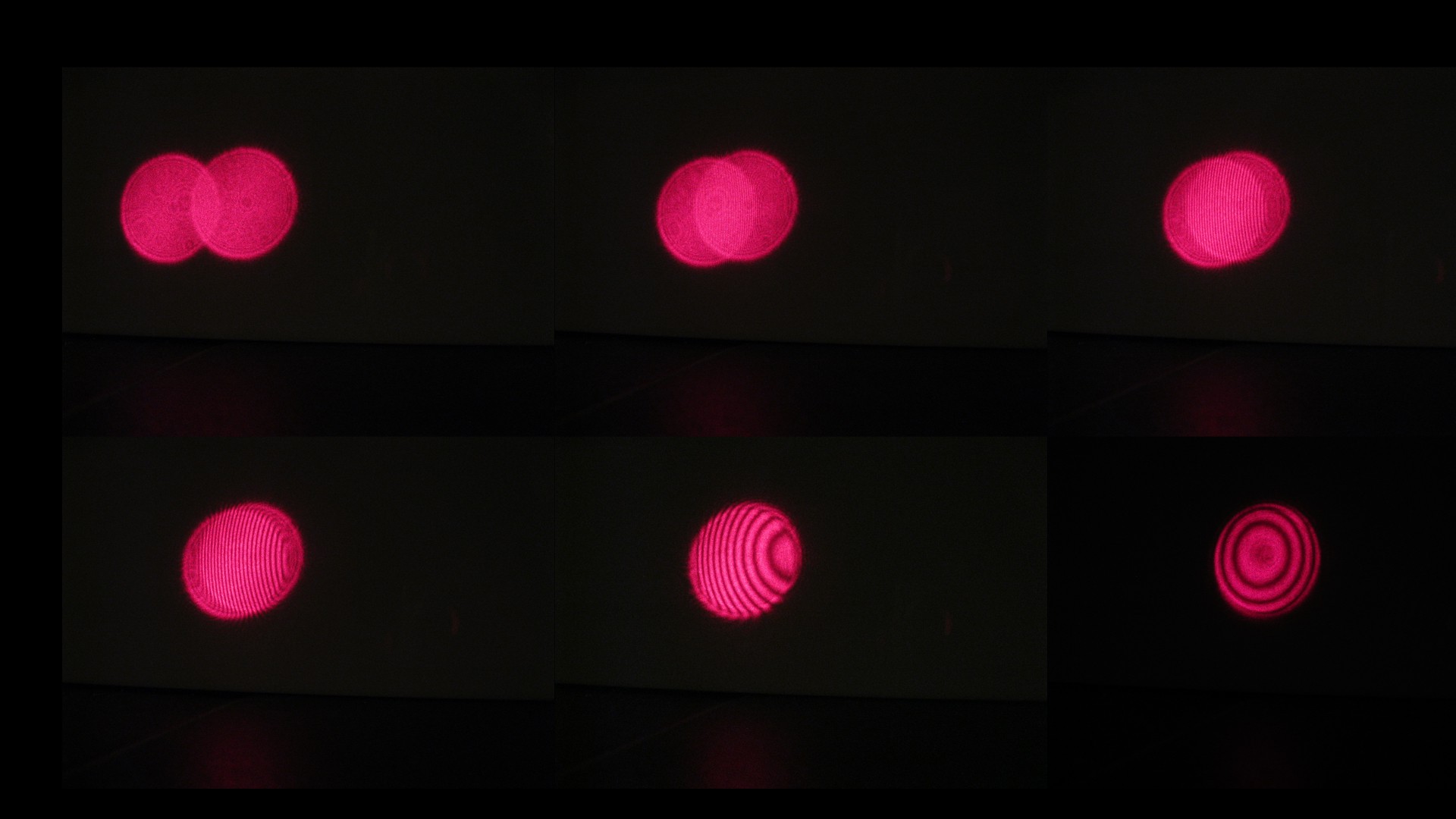Michelson interferometer
A Michelson interferometer made (mostly) by 3d printing and repurposing components from disassembled optical drives.
A Michelson interferometer made (mostly) by 3d printing and repurposing components from disassembled optical drives.
To make the experience fit your profile, pick a username and tell us what interests you.
We found and based on your interests.
So far I just implemented the simplest controllable current source circuit that I could find in Horowitz and Hill. I use the Teensy 3.1 DAC output in order to set the voltage on the base of a generic npn transistor. Then Ic = (Vb-0.6)/R, where R is the collector resistor. A better current source will use an op-amp in order to remove the 0.6 V offset and linearise the response. But here is the simple transistor circuit.
 By measuring the voltage, with the Teensy 3.1 ADC, across the 10 Ohm resistor it was possible to check if this circuit was behaving as expected. Here is the result which I was pleasantly surprised by. While this circuit lacks many of the sophisticated features (ESD protection, slow start, etc) of a proper laser diode controller, it did allow me to start controllably driving the laser.
By measuring the voltage, with the Teensy 3.1 ADC, across the 10 Ohm resistor it was possible to check if this circuit was behaving as expected. Here is the result which I was pleasantly surprised by. While this circuit lacks many of the sophisticated features (ESD protection, slow start, etc) of a proper laser diode controller, it did allow me to start controllably driving the laser.

The interference fringes seen with the Michelson depend on a number of factors. Using the static, but angle tunable, mirror mounts I thought it would be interesting to take a sequence of photos as the mirrors were brought into alignment.
In the most misaligned image (top-left) two red circles are seen and there is initially no evidence of interference - the signature that light is a wave. As the mirrors are progressively aligned, linear interference fringes start to appear (see top-right), with the fringe separation depending on the relative angle between the mirrors. As the relative angle between the mirrors is reduced, the fringes appear to take on a hyperbolic character (bottom-left to bottom-middle). Finally, when there is close to zero angular misalignment, circular fringes are seen (bottom-right).
Actually, we only see the circular fringes since there is a difference in length between the two arms of the interferometer. If there were no length difference the bottom-right disc would be purely light or purely dark.
As a side comment it is interesting to note the angular precision achievable with the mirror mount. A set of three M2 machine screws are used to control the angle of the mirror, and from the images we can estimate that that it is easily possible to align to within 1/20 of a disc. The discs are 40 mm diameter and are projected onto a wall 500 mm away from the Michelson. This gives an angular precision of better than tan-1(2/500)=0.2 degrees.

In the previous log entry the static interference pattern was reported using one fixed mirror and one mirror mounted on a DVD voice coil, this mirror could in principle be moved but controlled motion wasn't yet investigated. However, plenty of uncontrolled motion (vibration) could be seen, this vibration problem has now been temporarily solved by placing the Michelson directly on a tiled floor.
Now onto the next stage. A maximum current of 330 microamps is passed through the voice coil using a digital output pin of the Teensy 3.1 in series with a 10 kOhm resistor. Since this is a PWM output the current can be varied from zero up to its maximum value, and I will do this in 256 steps. From inspection I expected about 60 microamps to give a wavelength of displacement, so it should be possible to move over several interference fringes.
A way of recording the fringes is also needed and here I use a OPT 101 photodiode and integrated transimpedance amplifier, in this case the gain is set by an external 100 kOhm resistor but actually it would have been better to use the internal 1 MOhm resistor, to achieve more gain. The area of the photodiode is 2.3 x 2.3 mm and I place it at the centre of the interference pattern which is about 60 mm in diameter. The photo below shows the interference pattern again.
My experiment goes as follows. The voice coil current is held at 0 microamps for 10 s, then it is ramped to its maximum value over 256 steps holding at each step for 100 ms and during this time recording the photodiode voltage using the Teensy ADC. The following graph displays two successive traces, showing 8 interference maxima and reasonable consistency between runs. From this data it is seen that the voice coil moves a wavelength (650 nm) about every 40 microamps, near the estimated value. So each data point is separated by 1.3 microamps corresponding to a mirror displacement of only 21 nm.

I'm quite excited that the path length control works so well. This implementation of the Michelson now enables precise distance, current and acceleration measurements and, after some further optimization, I will look into these aspects of the instrument.
Rather than having static mirrors in the Michelson, as in the first iteration, it will be more interesting to dynamically change the path length between the two arms of the interferometer. As the path length is changed by half a wavelength (650/2 nanometers) a bright fringe will turn into a dark fringe. An obvious choice will be to control the position of a mirror using the voice coil from a disassembled optical drive. Here is an example mechanism from a Sony Blu-Ray assembly (KES-400A), which provides two axis linear control of the objective lens. The about 1 mm of out-of-plane movement will be most interesting to us and is electrically actuated by the current passing through one of the coils. Moreover, there is some hope for sufficient mechanical stability since the depth of focus of the optical drive objective is a few microns, just a little more than the wavelength of light.
I didn't use the Blu-Ray mechanism but rather a DVD voice coil, with very similar behaviour. The coil resistance is 5 Ohms, and 100 mA is found to yield roughly 1 mm displacement - hence there will be about 600 microamps per wavelength of displacement. A 5 mm square aluminised silicon chip is glued onto the objective lens, replacing one of the static mirrors in the Michelson.
And, with this mirror it is still possible to see interference fringes (as below), though the Michelson now has become enormously sensitive to mechanical vibration. The inertia of the spring mounted mirror holder causes its motion to lag that of the base, making a rather sensitive but in this case unwanted accelerometer. Some thought needs to be given to this, and if needed the voice coil could be replaced by a piezo buzzer element which will have less mechanical dynamic range and should be less vibration sensitive. Driving the voice coil indeed does shift the interference pattern but I hope to improve the vibration situation before investigating properly.
For about a week I have been able to see interference fringes projected onto the wall with the Michelson. I have been able to see the linear fringe pattern due to the mirrors being angled with respect to each other as well as circular and hyperbolic fringes. It has taken a lot of hours to get to this point and I almost jumped out of my skin when I finally managed to make it work.
My immediate plan is to make my laser diode driver circuit a bit less jumpy and then I can move onto some more ambitious goals...
Create an account to leave a comment. Already have an account? Log In.
Thanks vazquez - I have been busy with other projects but am about to come back to this. In particular, I want to replace the laser with a LED so that it is totally safe as a science demonstration. So, I hope there will be a post on this shortly...
Become a member to follow this project and never miss any updates
Are you still active on this project? I worked on a Michelson/FT system 20 years ago using piezoelectric mirror displacement. You have vey interesting results.